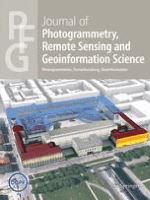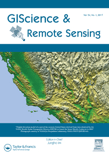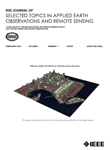
PFG-Journal of Photogrammetry Remote Sensing and Geoinformation Science
Scope & Guideline
Shaping the Future of Geographic Sciences
Introduction
Aims and Scopes
- Photogrammetry and 3D Reconstruction:
Research in photogrammetry encompasses methodologies for capturing, processing, and analyzing spatial data to create accurate 3D models. This includes advancements in image-based techniques and the application of UAVs and other sensor technologies. - Remote Sensing Applications:
The journal emphasizes the use of remote sensing technologies for environmental monitoring, disaster management, urban planning, and resource management. It includes studies that leverage satellite and airborne data to address real-world issues. - Machine Learning and AI in Geoinformatics:
A growing focus on integrating machine learning and artificial intelligence techniques into geoinformatics, enhancing data analysis, classification, and predictive modeling in various applications. - Land Use and Environmental Monitoring:
The journal covers research on land use changes, urbanization, and environmental impacts, utilizing geospatial data to assess trends and inform policy decisions. - Geospatial Data Integration and Analysis:
Exploration of methods for integrating diverse geospatial data sources, including multi-sensor and multi-temporal datasets, to improve analysis and decision-making processes. - Technological Innovations in Geoinformation:
Highlighting advancements in sensor technologies, data processing algorithms, and visualization techniques that contribute to the field of geoinformation science.
Trending and Emerging
- Deep Learning and AI Applications:
There is a significant increase in studies applying deep learning and AI techniques for tasks such as image classification, object detection, and semantic segmentation in geospatial contexts. - Integration of Multi-Sensor Data:
Research increasingly focuses on integrating data from various sensors (e.g., optical, radar, LiDAR) to enhance accuracy and provide comprehensive insights for complex geospatial problems. - Real-Time Monitoring and Analysis:
Emerging themes include the development of real-time monitoring systems for environmental changes, disaster response, and urban dynamics, reflecting the need for timely data in decision-making. - Urbanization and Land Use Dynamics:
There is a growing emphasis on analyzing urbanization patterns and land use efficiency, driven by global challenges such as climate change and sustainable development goals. - Environmental and Coastal Monitoring:
Research on coastal vulnerability, sea-level rise, and environmental impacts is gaining traction, highlighting the importance of remote sensing in addressing climate-related issues. - Spatial Digital Twins and Virtual Environments:
The concept of spatial digital twins is emerging, focusing on creating virtual representations of real-world environments for planning, simulation, and analysis.
Declining or Waning
- Traditional Photogrammetry Techniques:
There is a noticeable decrease in publications focusing solely on traditional photogrammetry techniques, as the field increasingly embraces automation, machine learning, and UAV technologies for data acquisition and processing. - Focus on Historical Methods:
Research centered on historical methodologies or archival studies in photogrammetry and remote sensing is becoming less frequent, suggesting a shift towards contemporary applications and innovations. - Static Geospatial Analysis:
Themes related to static or less dynamic geospatial analyses are declining, as the trend moves towards real-time and dynamic monitoring techniques, particularly in disaster management and environmental monitoring. - Manual Data Processing Techniques:
The reliance on manual data processing and analysis methods is diminishing, with a clear shift towards automated and AI-driven approaches, which are more efficient and scalable. - Applications of Aerial Photography in Isolation:
The standalone use of aerial photography without integration with other data sources is less common, as interdisciplinary approaches that combine various data types gain prominence.
Similar Journals

Remote Sensing
Unlocking the Secrets of Our Planet with Cutting-Edge ResearchRemote Sensing is a highly esteemed journal published by MDPI, dedicated to the domain of Earth and Planetary Sciences. With an impressive impact factor reflected in its rank of #16 out of 195 in the general Earth and Planetary Sciences category, this journal achieves a commendable 92nd percentile among its peers, indicating its significant contribution to the field. Since its inception in 2009 as an Open Access journal, it has enabled researchers, professionals, and students from around the globe to access high-quality, peer-reviewed articles that delve into the latest advancements in remote sensing technologies, methodologies, and applications. Based in Switzerland, Remote Sensing serves as a vital platform for disseminating innovative research that supports and enhances our understanding of Earth's processes and environments, ensuring scientific knowledge remains freely accessible and impactful.

Quaestiones Geographicae
Connecting Researchers to the Heart of GeographyQuaestiones Geographicae, an esteemed open-access journal published by SCIENDO, serves as a vital platform for scholarly communication in the field of Earth and Planetary Sciences. Since its inception in 1979, the journal has been dedicated to promoting rigorous research and discourse in geography, encompassing a breadth of topics that reflect the dynamic nature of the discipline. With an impressive Impact Factor belonging to the Q3 quartile category, the journal actively contributes to the global scientific community's understanding of geographical phenomena. Its commitment to open-access publishing since 2010 ensures that groundbreaking research is accessible to a wider audience, facilitating collaboration and innovation. As part of its enduring legacy, Quaestiones Geographicae engages researchers, professionals, and students alike, inviting them to explore, share, and expand the boundaries of geographical knowledge.

GIScience & Remote Sensing
Pioneering Insights in Earth and Planetary SciencesGIScience & Remote Sensing, published by Taylor & Francis Ltd, stands as a leading journal in the realm of Earth and Planetary Sciences, holding a prestigious Q1 ranking. Since its transition to Open Access in 2022, the journal has significantly broadened its reach, enabling researchers, professionals, and students across the globe to disseminate and access cutting-edge research related to geographic information science and remote sensing technologies. With a focus on publishing high-quality, peer-reviewed articles that contribute to the understanding of the Earth’s processes, environments, and interactions, this journal not only supports advancements in scientific knowledge but also fosters interdisciplinary collaboration. Based in the United Kingdom, GIScience & Remote Sensing continues to pave the way for innovative methodologies and applications, solidifying its vital role within the scientific community.

Journal of Geography-Chigaku Zasshi
Innovating Research to Illuminate Global ChallengesJournal of Geography - Chigaku Zasshi is a distinguished publication that serves as a crucial platform for the dissemination of research in the realm of geography and earth sciences. Published by the TOKYO GEOGRAPHICAL SOC in Japan, this journal is indexed with an ISSN of 0022-135X and an E-ISSN of 1884-0884. With a scope that includes Earth-Surface Processes, Geography, Planning and Development, Geology, Geophysics, and Global and Planetary Change, it provides comprehensive coverage of pressing geographical issues. Although it holds a Q4 ranking in multiple categories as of 2023, the journal presents an opportunity for researchers, professionals, and students to contribute meaningful findings in a diverse and competitive landscape. The Journal of Geography actively promotes scholarly dialogue by embracing the complexities of our planet and encouraging innovative approaches to geographical inquiries. This open-access journal aspires to bridge gaps and foster collaboration among scholars worldwide, underscoring its importance in understanding and addressing contemporary geographic challenges.

Advances in Geodesy and Geoinformation
Innovating the Landscape of Earth SciencesAdvances in Geodesy and Geoinformation is a pioneering journal published by the Polish Academy of Sciences, dedicated to the dynamic fields of geodesy and geoinformation. With an ISSN of 2720-7242 and an E-ISSN of 2720-7242, it offers an open-access platform since 2022, making cutting-edge research readily accessible to a global audience. The journal aims to foster the dissemination of innovative methodologies, technologies, and applications in the realms of geospatial data and earth sciences. Researchers, professionals, and students alike can benefit from the high-quality articles that contribute to advancing knowledge in this critical area, bridging theoretical insights and practical solutions. Situated in the heart of Poland, at PL Defilad 1, Warszawa, the journal not only reflects the nation's academic rigor but also positions itself as a crucial hub for international collaboration and knowledge exchange in geodesy and geoinformation.

Applied Geomatics
Transforming data into actionable solutions for real-world challenges.Applied Geomatics is an esteemed academic journal published by SPRINGER HEIDELBERG, dedicated to advancing the field of geomatics through rigorous research and innovative applications. With an ISSN of 1866-9298 and an E-ISSN of 1866-928X, this journal has gained a prominent standing in multiple disciplines, achieving a Q2 ranking in esteemed categories such as Earth and Planetary Sciences, Engineering, Environmental Science, and Geography. The journal's convergence of research from 2009 to 2024 positions it as a vital resource for both scholars and practitioners seeking to understand and leverage geomatic technologies in real-world scenarios. Located in Germany, Applied Geomatics not only contributes to theoretical advancements but also to practical methodologies that address current environmental challenges. Its accessibility and relevance ensure that the findings discussed within its pages are pivotal for professionals, researchers, and students alike, fostering collaboration and innovation within the field.

International Journal of Applied Earth Observation and Geoinformation
Bridging Science and Technology for Global Change.International Journal of Applied Earth Observation and Geoinformation is a premier peer-reviewed journal published by Elsevier, focusing on the integration and application of earth observation and geoinformation technologies across diverse fields. With an open access model established in 2020, this journal enhances accessibility and dissemination of research crucial for addressing global challenges related to climate change, resource management, and sustainable development. The journal occupies a notable position within the academic community, featuring a Q1 ranking in multiple categories including Computers in Earth Sciences, Earth-Surface Processes, and Global and Planetary Change, reflecting its significant impact and relevance in these disciplines. It is recognized for its high-quality articles that explore innovative methodologies and applications, making it an essential resource for researchers, practitioners, and students alike who seek to advance their understanding of earth dynamics and geospatial technology. The journal is indexed in Scopus with impressive rankings that underscore its high citation impact and scholarly influence, with an emphasis on providing a platform for the latest findings in management, monitoring, and policy in environmental science.

Vietnam Journal of Earth Sciences
Bridging Local Insights with Global Impact in Earth SciencesThe Vietnam Journal of Earth Sciences, ISSN 0866-7187, is a premier publication from the Publishing House Science and Technology based in Viet Nam, dedicated to fostering advancements in the field of Earth and Planetary Sciences. Operating under a Q2 ranking in the 2023 category of Earth and Planetary Sciences (miscellaneous) and positioned at Rank #62 out of 195 in its general category on Scopus, this journal serves as a critical platform for researchers, professionals, and students seeking to disseminate and engage with high-quality scientific findings. Despite being part of the non-open access model, the journal is committed to providing compelling content, encompassing a range of topics from geological hazards to environmental sustainability, ensuring its relevance and contribution to both local and international scientific communities. With coverage that spans from 2018 to 2024, the journal is poised to continue its role in addressing pressing Earth science issues and fostering collaborations among scholars in an increasingly interconnected world.

Earth System Science Data
Catalyzing Insights into Earth's Complex SystemsEarth System Science Data, published by COPERNICUS GESELLSCHAFT MBH, is a premier open access journal dedicated to advancing the field of Earth and planetary sciences. With an impressive impact factor, it holds a distinguished Q1 ranking in the Earth and Planetary Sciences category, underscoring its significance within the scientific community. Established in 2009, the journal has been committed to providing a platform for the dissemination of high-quality, freely accessible research data that supports the understanding and management of Earth's complex systems. The journal welcomes contributions that offer extensive datasets, innovative methodologies, and collaborations that push the frontiers of Earth sciences, making it an essential resource for researchers, professionals, and students alike. Based in Göttingen, Germany, Earth System Science Data remains a vital asset for those seeking to engage with and contribute to impactful scientific discourse across the globe.

IEEE Journal of Selected Topics in Applied Earth Observations and Remote Sensing
Bridging Knowledge and Technology in Earth Sciences.IEEE Journal of Selected Topics in Applied Earth Observations and Remote Sensing is a premier peer-reviewed journal published by the IEEE-INST ELECTRICAL ELECTRONICS ENGINEERS INC, focused on advancing the field of Earth observation and remote sensing technologies. With an impressive impact factor, this journal ranks in the top quartile (Q1) for both Atmospheric Science and Computers in Earth Sciences, underscoring its significance and influence in the academic community. Open access since 2020, it facilitates broader dissemination of research findings to enhance global visibility and accessibility for researchers, professionals, and students alike. Spanning the years from 2008 to 2024, the journal covers a myriad of topics that highlight innovative applications of remote sensing data and technologies in addressing environmental challenges. With a Scopus ranking placing it in the 91st and 89th percentiles, respectively, in its categories, the journal serves as a vital resource for advancing scholarly discourse and collaboration in Earth sciences.